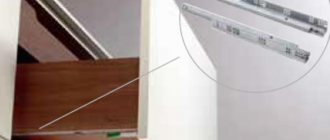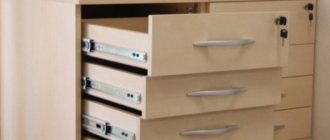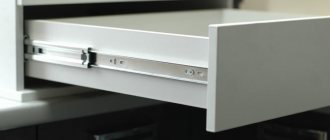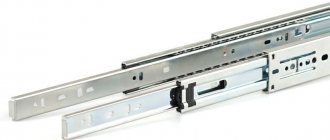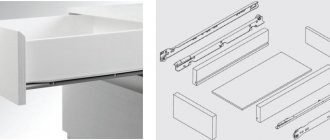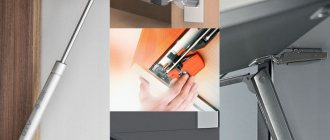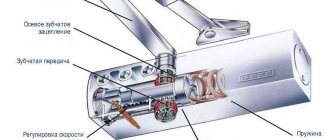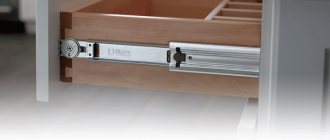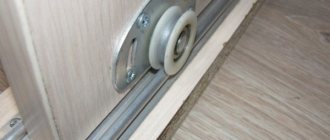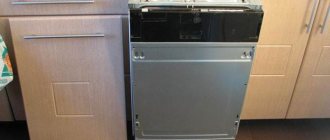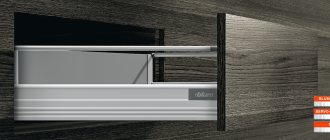Telescopic guides for drawers are modern fittings that allow you to effortlessly open even massive structures. Despite the fact that in almost any piece of furniture you can find drawers that can be pulled out due to the installation of special fittings, telescopic (or as they are also called ball) guides have gained great popularity only in recent years.
Today we will take a detailed look at their features and types, talk about how such fittings work, what advantages and disadvantages they have. We will also tell you step-by-step about the installation of telescopic drawer systems and simple repair of the guides, which you can do yourself.
Telescopic guides for drawers
Features of telescopic systems
Ball guides have a fairly simple design; their mechanism consists of main and auxiliary parts - these are metal runners and balls, as well as stopper elements and other limiters, which can be metal or plastic.
Telescopic guides are technologically advanced, durable fittings
This system greatly simplifies the operation process.
In order to understand the mechanism of their operation, we will consider the simplest version of two-section non-demountable telescopes. In this case, there are two rails that differ in size and are U-shaped, so that one part can fit into the other.
The mechanism is driven by moving metal tracks
There are small balls in the upper or lower part (between the parts), and the stopper is represented by the protruding edge of the rail. So in a certain area its movement stops.
The system received this name due to the fact that one track is placed inside another and extends like a telescope.
What types of ball guides are there?
Depending on the purpose, telescopic guides are distinguished by shape and other functions. Basically, they are divided according to the following characteristics:
- collapsible and non-dismountable mechanisms;
- two-section or multi-section (number of steps);
- multi-level or single-level.
The fittings have various mounting options
Telescopes can be installed both on the sides and in grooves
The difference between non-separable mechanisms is their rather low cost compared to analogues. This difference is due to some difficulties in the production of collapsible rails and a specific method of fixing the balls, because the structure must be designed in such a way that the guide can be disassembled without losing small elements.
Easy movement of boxes made of any materials is ensured by special balls
Of course, the cost is also influenced by the number of stages of the mechanism. This is also due to the peculiarities of the production of more complex parts.
Guides for this type of drawer come in a variety of colors, including black, steel, and zinc yellow. Balls are made of steel and nylon. It is worth noting that plastic balls are the quietest.
In most cases, drawers in cabinets with sliding doors are installed on telescopic guides
Electric oven Midea MO68100GB
Electric oven Midea MO68100GB Kitchen appliances Built-in ovens
0,00₽
Start shopping
Three-level telescopic guides
They make it possible to simultaneously pull out sheets on three platforms. However, many users find it inappropriate to extend all three elements when the pan is only at one level.
Combined telescopic guides
Combines the properties of partial and three-level. In this option, only one sheet, located at the desired level, is fully extended, the rest are at a shorter distance.
Thanks to the variety of types, users can purchase kitchen appliances with retractable telescopic guides, guided by their ideas about convenience.
Advantages and disadvantages of ball guides
Any mechanism has certain advantages and disadvantages. Such features should be taken into account before choosing one or another fitting for installation.
Table 1. Pros and cons of installing ball guides
| Advantages | Flaws |
|
|
Telescope mechanism suitable for massive iron boxes
The role of ball guides in furniture production
Despite the fact that ball guides are used in various industries, such fittings are most popular in furniture manufacturing.
Most often they are installed in various wardrobe systems, chests of drawers, cabinets. This means that they can be found in any type of furniture that is designed for comfort and space saving. It is worth noting that the presence of such a system greatly simplifies the use of sliding cabinets.
A bed with drawers mounted on telescopic fittings
Spare parts catalog | Telescopic guides for stoves and ovens 45 products
Information on mandatory confirmation of conformity of goods is presented in the manner and in the ways established by the legislation of the Russian Federation on technical regulation, and includes information on the number of the document confirming such conformity, its validity period and the organization that issued it.
12. An offer of a product in its description addressed to an indefinite number of persons is recognized as a public offer if it is sufficiently defined and contains all the essential terms of the contract.
The seller is obliged to enter into an agreement with any person who has expressed an intention to purchase the goods proposed in his description.
13. The seller is obliged to inform the buyer about the period during which the offer to sell goods remotely is valid.
14. If the buyer sends a message to the seller about his intention to purchase the goods, the message must include:
a) the full company name (name) and address (location) of the seller, surname, name, patronymic of the buyer or the person indicated by him (recipient), the address to which the goods should be delivered;
b) name of the product, article number, brand, variety, number of items included in the package of the purchased product, price of the product;
c) type of service (if provided), time of its execution and cost; d) buyer's obligations.
15. The buyer’s offer to send goods by post to the address “Poste restante” can only be accepted with the consent of the seller.
16. The seller must ensure the confidentiality of personal data about the buyer in accordance with the legislation of the Russian Federation in the field of personal data.
17. An organization that sells goods remotely provides the buyer with catalogs, booklets, brochures, photographs or other information materials containing complete, reliable and accessible information characterizing the goods offered.
18. The seller’s obligations to transfer the goods and other obligations associated with the transfer of goods arise from the moment the seller receives the buyer’s corresponding message about the intention to conclude an agreement.
19. The seller has no right to offer the consumer goods that are not specified in the initial offer of goods for sale.
It is not permitted to transfer to the consumer goods that do not comply with the preliminary agreement if such transfer is accompanied by a requirement to pay for the goods.
20. The contract is considered concluded from the moment the seller issues a cash or sales receipt or other document confirming payment for the goods to the buyer, or from the moment the seller receives a message about the buyer’s intention to purchase the goods.
When the buyer pays for goods in non-cash form or sells goods on credit (except for payment using bank payment cards), the seller is obliged to confirm the transfer of goods by drawing up an invoice or a goods acceptance certificate.
21. The buyer has the right to refuse the goods at any time before its transfer, and after the transfer of the goods - within 7 days.
If information on the procedure and timing for returning goods of proper quality was not provided in writing at the time of delivery of the goods, the buyer has the right to refuse the goods within 3 months from the date of delivery of the goods.
Return of a product of proper quality is possible if its presentation, consumer properties, as well as a document confirming the fact and conditions of purchase of the specified product are preserved. The buyer's absence of this document does not deprive him of the opportunity to refer to other evidence of the purchase of goods from this seller.
The buyer does not have the right to refuse a product of proper quality that has individually defined properties if the specified product can be used exclusively by the consumer purchasing it.
If the buyer refuses the goods, the seller must return to him the amount paid by the buyer in accordance with the contract, with the exception of the seller’s expenses for delivery of the returned goods from the buyer, no later than 10 days from the date the buyer presents the corresponding demand.
22. If the contract is concluded with the condition that the goods be delivered to the buyer, the seller is obliged to deliver the goods to the place specified by the buyer within the period established by the contract, and if the place of delivery of the goods is not specified by the buyer, then to his place of residence.
To deliver goods to the place specified by the buyer, the seller may use the services of third parties (with mandatory informing the buyer about this).
23. The seller is obliged to transfer the goods to the buyer in the manner and within the time limits established in the contract.
If the contract does not specify the delivery time for the goods and there is no way to determine this period, the goods must be transferred by the seller within a reasonable time.
An obligation not fulfilled within a reasonable time must be fulfilled by the seller within 7 days from the date the buyer submits a demand for its fulfillment.
For violation by the seller of the deadlines for transferring the goods to the buyer, the seller is liable in accordance with the civil legislation of the Russian Federation.
24. If the delivery of the goods was made within the terms established by the contract, but the goods were not transferred to the buyer through his fault, subsequent delivery is made within a new time frame agreed with the seller, after the buyer has re-paid the cost of services for delivery of the goods.
25. The seller is obliged to transfer to the buyer goods, the quality of which corresponds to the contract and the information provided to the buyer when concluding the contract, as well as information brought to his attention when transferring the goods (in the technical documentation attached to the goods, on labels, by marking or other means provided for certain types of goods).
If there are no conditions in the contract regarding the quality of the goods, the seller is obliged to transfer to the buyer goods suitable for the purposes for which goods of this kind are usually used.
If the seller, at the conclusion of the contract, was informed by the buyer about the specific purposes of purchasing the goods, the seller is obliged to transfer to the buyer the goods suitable for use in accordance with these purposes.
Unless otherwise provided by the contract, the seller is obliged, simultaneously with the transfer of the goods, to transfer to the buyer the relevant accessories, as well as documents related to the goods (technical passport, quality certificate, operating instructions, etc.) provided for by the legislation of the Russian Federation.
26. The delivered goods are transferred to the buyer at his place of residence or other address indicated by him, and in the absence of the buyer - to any person who presents a receipt or other document confirming the conclusion of the contract or registration of delivery of the goods.
27. If the goods are transferred to the buyer in violation of the terms of the contract regarding the quantity, assortment, quality, completeness, packaging and (or) packaging of the goods, the buyer may notify the seller of these violations no later than 20 days after receiving the goods.
If defects are discovered in a product for which warranty periods or expiration dates have not been established, the buyer has the right to make claims regarding defects in the product within a reasonable time, but within 2 years from the date of its transfer to the buyer, unless longer periods are established by law or contract.
The buyer also has the right to make claims against the seller regarding defects in the goods if they are discovered during the warranty period or expiration date.
28. The buyer to whom goods of inadequate quality were sold, unless this was agreed by the seller, has the right, at his own discretion, to demand:
a) free elimination of defects in the goods or reimbursement of expenses for their correction by the buyer or a third party;
b) a proportionate reduction in the purchase price;
c) replacement with a product of a similar brand (model, article) or with the same product of a different brand (model, article) with a corresponding recalculation of the purchase price. Moreover, in relation to technically complex and expensive goods, these buyer requirements are subject to satisfaction if significant deficiencies are discovered.
29. The buyer, instead of presenting the demands specified in paragraph 28 of these Rules, has the right to refuse to fulfill the contract and demand a refund of the amount paid for the goods. At the request of the seller and at his expense, the buyer must return the defective goods.
The buyer also has the right to demand full compensation for losses caused to him as a result of the sale of goods of inadequate quality. Losses are compensated within the time limits established by the Law of the Russian Federation “On the Protection of Consumer Rights” to satisfy the relevant requirements of the buyer.
30. If the seller refuses to transfer the goods, the buyer has the right to refuse to fulfill the contract and demand compensation for losses caused.
31. When returning goods of inadequate quality, the buyer’s lack of a document confirming the fact and conditions of purchase of the goods does not deprive him of the opportunity to refer to other evidence of the purchase of goods from the seller.
32. Information on the procedure and terms for returning goods by the consumer must contain: a) the address (location) of the seller to which the goods are returned;
b) the seller’s working hours;
c) the maximum period during which the goods can be returned to the seller, or the minimum period specified in paragraph 21 of these Rules;
d) a warning about the need to preserve the presentation, consumer properties of the goods of proper quality until they are returned to the seller, as well as documents confirming the conclusion of the contract;
e) the period and procedure for returning the amount paid by the buyer for the goods.
33. When the buyer returns goods of proper quality, an invoice or a certificate of return of goods is drawn up, which indicates:
a) full corporate name (name) of the seller; b) last name, first name, patronymic of the buyer;
c) name of the product;
d) dates of conclusion of the contract and transfer of goods; e) the amount to be returned;
f) signatures of the seller and buyer (buyer’s representative).
The seller’s refusal or evasion to draw up an invoice or act does not deprive the buyer of the right to demand the return of the goods and (or) the return of the amount paid by the buyer in accordance with the contract.
34. If the refund of the amount paid by the buyer in accordance with the contract is not carried out simultaneously with the return of the goods by the buyer, the refund of the specified amount is carried out by the seller with the consent of the buyer in one of the following ways:
a) in cash at the location of the seller; b) by postal order;
c) by transferring the appropriate amount to the bank or other account of the buyer specified by the buyer.
35. The costs of returning the amount paid by the buyer in accordance with the agreement are borne by the seller.
36. Payment for goods by the buyer by transferring funds to the account of a third party specified by the seller does not relieve the seller of the obligation to return the amount paid by the buyer when the buyer returns goods of both proper and inadequate quality.
37. Monitoring of compliance with these Rules is carried out by the Federal Service for Surveillance on Consumer Rights Protection and Human Welfare. (clause 37 as amended by Decree of the Government of the Russian Federation dated October 4, 2012 N 1007)
Installation of telescopic guides
We will consider the option of mounting telescopes using the example of the lower part of a kitchen table with drawers.
Calculations
At the very beginning, we need to determine the length and types of guides that will be used during further installation.
The basis will be a table of standard dimensions: length 520 millimeters and height 720 millimeters
The first type is a two-row incomplete extension design, and in our case such a mechanism will not work. The second type is the four row full extension slides which are perfect for this desk.
Next, you will need to determine the length of the sidewall, in this case it is equal to 520 millimeters, the type of back wall of the invoice. Even if the design assumes the presence of an inset wall, a 500 mm guide will still fit. Therefore, in any case, it will be optimal to choose exactly this length, but the method of fixing the back wall must be taken into account.
All calculations must be carried out starting from the facades
In this case, we will have 3 facades of 140 millimeters each and 1 facade of 292 millimeters. Calculating the length of the facades is quite simple. You just need to know the height of the case, which in this case is 720 millimeters.
This can be calculated using the following example, in the end we got 712 millimeters, which we divided into four facades
It should be borne in mind that each manufacturer has its own standard range of parts and most often the changes relate specifically to the height of the facades.
In order to correctly place the markings on the sides of the structure, it is necessary to consider the location of the drawers
Now you need to figure out how to calculate these dimensions. In this case, it is necessary to take into account the value of the lower indentation, which is 17 millimeters. So, the distance from the floor to the first box will be 25 millimeters, now you should add the height of half of this box, in this case it is 50 millimeters. The result was 75 millimeters.
The next size can be obtained taking into account the height of the lower facade. Here you should add 2 millimeters for the gap and another half from the other box. This is based on the fact that the boxes are 100 millimeters high and are located in the central part of the narrow facades, which are 140 millimeters high. Thus, 140 should be divided by 2 - it turns out 70 millimeters, which we add.
The next two calculations can be obtained by adding the previous ones
This means that 142 millimeters will need to be added to the dimensions that we have already received. Most often, the guides are installed before assembling the case itself, so you can simply subtract 16 millimeters from previous calculations or determine the values along the entire chain.
Next we will look at how to calculate the width of the drawers. In this case, our table length is 600 millimeters. Since in most cases laminated chipboard or MDF measuring 16 millimeters is used in furniture production, we will need to subtract 32 millimeters from the total width of the structure.
Determining the width of the drawers
In addition, from the resulting value of 568 millimeters, you will need to subtract another 26 millimeters for gaps.
Video - Installation of telescopic guides: calculations
Installation
Upon completion of all preliminary calculations, you can now move on to the practical part - installing telescopic guides.
The next two calculations can be obtained by adding the previous ones
Example of fixation on fiberboard
It is important to note one more digression - if you use guides on rollers, then the fiberboard bottom can be fixed to furniture nails. In the case of ball guides, it is recommended to use self-tapping screws as fasteners; in this case, you can also make an inset bottom.
Step-by-step instruction
Step one: the first thing we need to do is detach the inner part and attach it to the axle that divides our box into two parts. The guide has many holes for adjustment. In this case, we will start with longitudinal adjustment.
Attach the guide to the marking
Step two: you need to make a longitudinal adjustment so that the edge of the guide on the front is flush with the front edge of the side panel. After which you can already adjust the height.
Adjusting the location of the guide
Step three: after the work has been done, you need to begin installing the main part of the guide to the side of the table. Essentially, the mounting principle is the same, but in most cases there is no way to adjust the height. That is why when purchasing guides it is necessary to take this principle into account, because mechanisms with additional adjustment have a higher cost. Budget options were used here.
Installation of the main guide
Step four: the last step is to secure the drawers in place and check their functionality. You can insert all four drawers at once or one at a time.
Putting the boxes in place
Step five: the last step is to secure the facades. This should be done using double-sided adhesive tape and self-tapping screws (as shown in the image).
We install facades
There should be a gap of two millimeters between the facades. In order to make it, you should take a PVC edge tape of this diameter or any other object of the same width.
Calculation of the dimensions of the future box
When designing furniture, the measurer must take into account the correct technological measurements when assembling the drawer on which the guide will be installed.
He must calculate that there is a gap of 13 mm on both sides between the assembled product and the outer side of the cabinet. This size is needed to ensure that the mechanism fits and works correctly.
In a hardware store you can find guides from 250 mm. In addition to the gap on the sides, it is necessary to leave a gap between the drawer and the cabinet at the back of about 10-15 mm.
Of course, there are also non-standard sizes of the cabinet itself. Then you can move away a little from the general dimensions.
For example, we have only 395 mm of free space for a drawer, not 400 mm. In this case, we can take a smaller telescopic guide.
The drawer will not open completely, but in this way we save 35 mm of the space the owner needs.
As for the height of the box itself, its size is taken from the wishes of the customer. It can range from 70 to 250 mm.
Repair of roller guides
Despite the fact that telescopic guides are considered the most durable compared to other options, in some cases failures occur. Of course, under such circumstances, you can replace the fittings, but it is still worth trying to repair it.
In this case, we will look at repairs using the example of full extension ball guides. The breakdown is that the plastic retainer has become unusable. It allows you to hold the box, thereby preventing it from jumping out of the rail.
Plastic retainer
Thin plastic can break during use, as happened in our case.
Of course, such a breakdown does not have any effect on the operation of the guide itself, but the box will not be fixed properly. Therefore, if you push it all the way, it will simply fly out. This, in turn, is unsafe because massive boxes can fall on your feet. That is why, if there is no stopper, they should not be pulled out.
Video - How to remove a drawer with ball guides
Telescopic guide repair instructions
Step one: you need to take a wire with a diameter of 2 millimeters. In this case, strong stainless steel wire is used, but you can use another one. At the same time, it should spring a little. In total, we will need to cut 9 centimeters from it (maybe a little longer or shorter) - this is the standard length of the clamp in any type of guide. The mechanism used here is 50 centimeters long, but it can be shorter.
Wire with a diameter of 2 millimeters
Step two: stepping back 1 centimeter, you need to make a bend at the end of the wire. Next, use a tape measure to measure another 2 centimeters from this bend and make another one.
The result should be something like this, which will now need to be bent in the opposite direction
Step three: now you should step back from the edge about 5 millimeters and bend it in the other direction. First, we get a small bevel, which will not be enough for a stopper, so we take another pliers. Next, we use two pliers to make the maximum bend.
Now we have a more durable clamp
Step four: you need to step back another 3 centimeters from this bend, and make another bend in the wire. The main thing is that all bends should be exclusively in the same plane, otherwise you will end up with a crooked latch that will not work properly.
Let's make a bend like this
Now, using pliers, you need to make such an eye at the end
Now you need to hammer in the latch using the same tool
At this stage our fixative is ready. Compared to a plastic product, it will last for many years, and besides, it is quite easy to make it at home. If desired, you can prepare a wire of 10 centimeters - a long clamp will work more smoothly.
Full extension telescopic slides made of stainless steel
For one of my tasks, I needed full extension guides, these are used all the time in ordinary furniture, and of course I would just go and buy them in a store, especially since they cost about 2-5 dollars, but a problem arose. The fact is that I needed stainless steel guides, but more details in the review. Not long ago I posted a video about the completion of an apartment renovation epic, but then I said that not everything was actually finished, and one of this “everything” was a mirror in the bathroom. The problem of installing a mirror lasted probably a year and a half or two, but the solution came quite unexpectedly when I was cleaning out the furniture in the kitchen. Here I remembered a phrase from the film “Guest from the Future” - we need a push. I tried so many options for this, but I came up with such a simple one completely by accident.
Actually, that’s why I needed stainless steel guides, but unexpectedly it turned out that we either don’t have these on sale at all, or they cost some completely absurd amounts of money. To give you an idea, what I found cost from 60-70 to 100-300 dollars per set, sometimes made to order.
But when I went to Aliexpress, I was surprised again, not only are there simply a huge number of them on offer, but there is also a decent selection of sizes at much more affordable prices.
In the end I ordered it and it cost 12.88. The size is the smallest, 10 inches, in addition there is an option with and without a closer, I took without. because for my task it is not only not needed, but also inconvenient.
It took a long time, maybe they just got on sale. The order was placed on November 22, received in early January. Inside the package are two guides and a set of fasteners.
I didn’t even need fasteners, but I’ll tell you about the guides themselves and their use in more detail.
I think that those who came to read this review hardly need to explain what full extension ball guides are and how they differ from partial extension guides, ball and roller, especially since the answer is partially visible in the photo.
On the store page there are explanatory drawings that make it easier to select guides, with explanations in Russian!
One guide (there are two in the set) weighs almost a quarter of a kilogram, width 44mm, length when folded 250mm, when unfolded almost 500.
The thickness of the metal turned out to be difficult to measure, I got something around 0.8mm, the total thickness of the mechanism is almost 13mm, usually those that are sold here are about 12.7mm. A nuance was also discovered, there is a noticeable side play, i.e. if you press the extending part in one direction or the other, the thickness at the edges will vary in the range from 12.27 to 13.63. In this case, this is a necessary evil, since the length of the part with the balls is short, but in fact, if you use them for their intended purpose, i.e. for furniture, it will not be noticeable at all.
Regarding the thickness of the metal and the thickness of the guide itself, the store had completely different data. In my case, this was not critical at all, but still unpleasant.
But in general they move very smoothly, all moving parts are generously lubricated with viscous lubricant.
The latch is moderately soft. With conventional guides, due to the strong fixation, I sometimes had to slightly loosen the “fork” that is fixed to it, here I liked it better, it holds, but I didn’t have to bend anything.
A plastic retainer is installed at the end; in fact, there are no differences here from conventional guides
One of the linear bearings, cage and balls.
The balls themselves, of course, are very magnetic, but the material of the guides, although magnetic, is noticeably weaker. Of course, someone will write that stainless steel should be non-magnetic. A typical misconception, stainless steel can be different, both magnetic and non-magnetic, in this case something in between, an ordinary magnet almost does not feel it, but neodymium sticks.
As you understand, the length of the guides was not chosen “out of the blue”; I previously drew on a scale the place where they would need to be installed. To do this, I used the tile layout drawing that I made for this bathroom, then I placed furniture, a niche, a rod for the curtain, etc. on it, then, trying different options, I chose both the length of the guides and decided on the dimensions of the future mirror.
I ordered the mirror from the Kharkov company Apex-Mdf, which used to be called Apex-style. Compared to the general background, it turned out to be inexpensive, with a size of 480x780mm, something around 650 UAH (25 dollars), but it took a long time to make, perhaps because of the New Year holidays. The only thing that surprised me was that I didn’t need glass in aluminum, but a mirror.
Well, since this is a bathroom, it is therefore humid there and so that all this does not rust, the mirror was in a frame made of an aluminum profile. There were several options to choose from, I chose F1 as a compromise between reliability and aesthetics.
I was a little surprised when I noticed that the mirror was installed for a reason, but had a white protective film on the back. I hope this will increase its service life, since our regular mirror at home has already deteriorated due to moisture.
Based on the drawings and photographs of the installation site, I decided on the installation location of the guides on the mirror frame; it was lucky that the edge of the guide just fell on the inside of the frame plane.
The principle of installing a mirror is extremely simple; it must be hung on guides. Initially I wanted to somehow screw it to them, but there is a “nuance” here, I could screw it, I could even install it later, but since in this case the guide clamps would be behind the mirror, it would no longer be possible to remove it. Alternatively, it was possible to install the guides “inside out”. the narrow part on the wall, and the wide part on the mirror, but even so it’s not a fact that everything would work out.
Therefore, I started by preparing the grooves for hanging. In order not to break the mirror, I first removed the top part, drew it, marked the locations of possible holes, and at the same time noted where the steel corner ends so as not to get caught in it.
The result is such grooves. As an option, it was possible to buy steel canopies, but you have to look for them, and besides, it’s not a fact that I would be more comfortable with them. I cut the top rail from the bottom so that the guide would not stick up.
Initially, I planned to drill holes in the guides, cut an M4 thread and screw the screws in there, then take two M4 nuts and, at a distance of 2-3 mm from the plane, touch each other to create pins that would fit into the grooves of the mirror frame. But since the most I could do was just drill it out, because of the thin metal the thread would have turned out weak, and I couldn’t make a stamp so that the metal would bend and the thread would be wider, so I had to “go the other way.”
I sharpened four M4 nuts on a grinder, and then screwed them onto the inserted screws, then a washer and a regular nut. I ground it so as not to drill out large holes, so 6.5mm was enough for me. Well, I used nuts to simplify things, although you could have taken some kind of tubes, but you have to look for them.
With the lower part, I did everything in approximately the same way, with the only difference that here the holes for the canopies were shifted upward, and for entry, a hole was drilled, rather than a groove being cut out. Unfortunately, a step drill couldn’t fit here; I had to take a core drill with a diameter of 16 mm. As a result, not only did I use a bunch of tools, I also finished it off with a needle file 
It turned out quite neatly, but due to the large diameter of the crown, the hole turned out to be literally end-to-end, the same goes for the centering drill, in the end I had to remove it altogether later so as not to go right through.
The last stage of preparation, over which I also had to rack my brains a little. To prevent the mirror from being accidentally removed from the awnings, it had to be secured somehow, not only securely, but also unnoticeably. The solution turned out to be elementary, screw in two screws from below; by the way, their length also took part in calculating the location of drilling holes in the floor hinge.
Everything is prepared and ready to be sent to the installation site.
And here is the place for the future installation, the whole problem was that it turned out to be a very bad place to install the mirror. The door of the niche for pipes cannot be moved, just like the niche itself, the same applies to the washbasin. If the door were to the right, then the mirror could be hung on the wall, if to the left, then on the door itself, but “neither here nor there.”
Then everything is standard, marking, drilling, installing guides. The only thing I had to use was long plugs, 8x65, due to the fact that there is also gypsum board between the tiles and bricks (as far as I remember). Before installing the guides, I glued double-sided tape, it makes it easier to install them and thanks to it it is more difficult to split the tiles since it was screwed with decent force.
The guides are installed.
Then I installed the removable part with the canopy pins, I think now it’s clear why everything was done that way. By the way, in this form you can remove them without any problems, either using some kind of hook, squeezing the latch, or simply unscrewing the screws.
We hang a mirror and that’s it. The last operation even went unnoticed, I took the mirror and just hung it on the wall, it wasn’t even interesting, I didn’t have to adjust anything, file it, etc. After hanging it, I screwed in two screws from below and now you can remove the mirror only by first unscrewing them.
The installation height was selected so that the mirror would not interfere with anything, including the opening/closing of the washbasin valve, and, as usual, there would probably be something on the washbasin itself. The distance from the mirror to the tile was about 15mm, I was afraid that the gap would be very visible, but in practice it is almost invisible.
Now, to access meters and taps, it’s easy enough to roll the mirror to the left and open the door. When closing, the guides are held in place by latches and you cannot accidentally move the mirror.
At this point we can say that the penultimate stage is over, perhaps it turned out not as aesthetically pleasing as we would like, some things should have been thought out from the beginning, but you can’t think of everything, alas. but now I have a solution to a similar problem, and perhaps it will be useful to someone.
The last stage remains, connecting the intercom, and here I am still “in the process”, although it would seem that there is nothing to do there. It turned out that everything is not so simple. What does an ordinary person do when he wants to connect an intercom? He calls the organization that services them and calls a specialist to draw up a contract and connect. But here everything turned out to be wrong. I found out the phone number of the organization that installed the entrance intercom, called, and after a while the master called me back. We talked and he explained that he had contacted the house manager and she said that in the original contract we did not pay for the installation of a floor switch for this apartment. Well, no, no, I say, count how much there is in there. I did the math, called back and announced the amount... about 70 dollars, of which about 30 for the switch and 40 for visiting and “programming” the switch. And I haven’t yet clarified whether this includes running the cable (12 meters) and the cable itself, apparently not.
Somehow I was a little upset by this amount and I went on the Internet to see what kind of switch it was, fortunately I am somewhat familiar with this area. It turned out that the usual BK-4MV manufactured by Vizit is used, and it costs not 30, but rather 20 dollars, i.e. and here they increased the price by one and a half. In general, when I went to hang the mirror, I simultaneously looked at what kind of switch it was, I had two options, the old 4MV or the new 4AV, which is distinguished by the presence of a jumper for connecting the terminal resistor along the video line and the ground wire. At the same time, the new version costs 22 dollars, the old version costs about 18, but they are no longer available. Having opened the shield, I saw what I thought, BK-4MV, one apartment out of four possible and out of six on the floor was connected. But in any case, I will have to install a separate switch. I asked the head of the house about installation without a “company”, she said that in this case the intercom is common house property, so I can easily buy the switch myself and invite another specialist, as well as install it myself.
Of course, I’m not greedy and usually prefer to pay, but somehow when they charge me an amount for “programming” a switch that is only half as much as it costs to install, for example, an air conditioner, and at the same time they charge one and a half prices on the switch itself, I’m a little I'm upset. Moreover, “programming” is extremely simple and is described in detail in the instructions in Russian. As a result, I agreed with a friend that we would install it together, he would run the cable, I would connect it and “program” it.
But first, I found a switch on the Internet; it cost about $22, but it was a newer version than the one installed. The difference is that the new one has a built-in video terminator connected by a jumper, as well as a wire for connecting to the building ground bus.
The kit included instructions and a set of jumpers, however, I read the instructions before purchasing. Along the way, I decided to troll a little, found the Visit case, but from a different device, and installed an adapter for a video intercom in it. Actually, there is nothing interesting in the switch, a microcontroller, a video amplifier.
In principle, it was possible to assemble a switch, since the principle of its operation is not very complicated, and in addition there is a circuit without the use of a microcontroller. But I decided that this would be too much, the economy should be economical.
Then, while my friend ran the cable, he connected everything. There were almost no problems, the intercom worked on the second try, but on the first try the polarity of the audio/control line was connected incorrectly. But an ambush emerged from the video: the monitor screen remained dark, although the signal itself was 100%, this was confirmed by a test with a tester and the subsequent connection of another monitor.
Just in case, I wrote my phone number on the switchboard, in case someone from this floor or the next needs help connecting.
I had to make a “call to a friend,” or rather to the company with which I work on video surveillance. I explained the problem, they called the dealer and he explained that they needed to switch the video standard. The bottom line is that the monitor is designed to work with both AHD cameras and regular ones. In general, I guessed about this myself, but there was no such item in the menu, or in the instructions either.
It turned out that the developers put this point in such a way that “you can’t figure it out without a bottle.” You need to select the required input, then press the intercom button, the brightness/contrast/saturation control menu will appear on the screen. In this menu you need to select R, the settings will be reset, the menu will go dark, but the monitor will switch to the next mode, there are three or four of them (AHD-N, AHD-P, CVBS-N, CVBS-P).
I chose the desired mode and everything worked as it should, the only thing I have a slight complaint about is that the approach camera has a 4:3 format, and the monitor is 16:9.
The process of installing and connecting the intercom was the last step in the repair, and although they say that the repair cannot be completed, I still finished it 
That's all for me, I hope it was useful.
Roller guides: what are their features?
In order to understand why many furniture makers choose telescopic guides, it is necessary to familiarize yourself with the structure of roller fittings.
Such mechanisms became available to a wide mass of buyers back in the 90s, when the first imported accessories began to be sold. In most cases, the products were manufactured in China, so they were not always of ideal quality, but there were exceptions.
Just a couple of decades ago, such mechanisms were considered very popular. They were used for furniture of any type, including cabinets, chests of drawers, and computer desks.
They are in the form of two planks, one of which is fixed to the wall of the structure, and the other to the box itself. The connection between them is represented by plastic rollers, thanks to which movement occurs.
Roller mechanism
The following positive aspects of installing roller guides can be noted:
- they are also distinguished by good strength;
- it is not difficult to repair such a structure yourself;
- they can be installed without the help of a professional technician;
- Guides of this type are characterized by a low price.
Roller guides are still used in budget furniture today.
In addition, the following negative aspects of installing such accessories are noted:
- it is impossible to pull out the drawers to the very end, because there must be some space left to connect the two parts of the guides;
- If installed incorrectly, there is a high probability of rapid breakdown of the mechanism;
- such fittings will not be able to support a box that is too massive, because the plastic rollers will simply break due to such pressure;
- plastic rollers wear out after a while - this leads to the fact that the drawers begin to constantly jam;
- less aesthetic appearance compared to telescopes.
Roller guides
What other retractable mechanisms are there?
There are other drawer systems:
- Metaboxes. This is the name of the retractable mechanism, which is based on roller guides. The system assumes only partial extension to three-quarters of the entire length. Such a box should carry a load of no more than 20 kilograms.
- Tandems. The mechanism is an open type guide. The system provides partial extension and smooth operation. The advantage is that the box will be easy to dismantle without specialized tools.
- Tandemboxes. These are the most expensive guides. The kit contains components for installing fittings to the facade and rear wall. Such a system sometimes involves automatic opening of the drawer - all you need to do is press the front.
Drawer on Tandembox guides
Let's sum it up
You should choose one or another type of retractable fittings based on the design features of the furniture and your personal preferences. At the same time, if you want to get a durable mechanism, then you should not save money on its purchase, because low-quality guides quickly jam and stop functioning. The best option today is a telescopic system, and the installation of such fittings can be done without the help of a specialist - you just need to have all the necessary tools and fasteners on hand.
